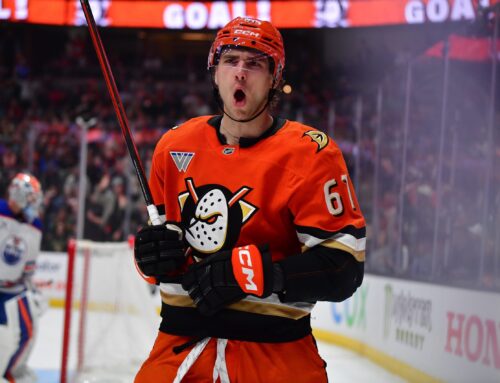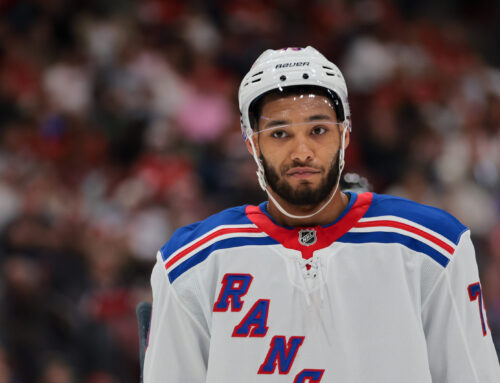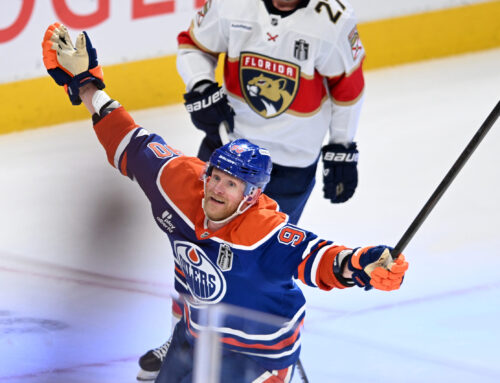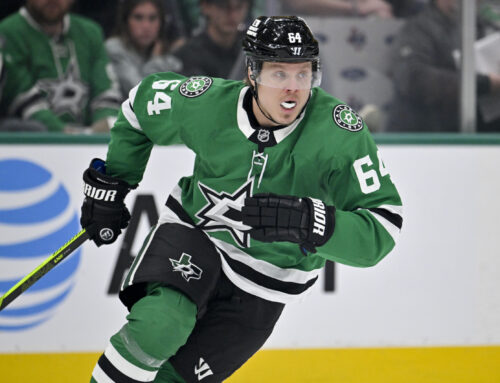Even though the NHL postseason is underway, fantasy general managers should already be looking ahead to next campaign.
While many like to wait until the offseason to see what happens with the draft, free agency and trades, it might be better to target certain players now. After all, some players will be cheaper now than later on, when everyone realizes that player is going to be playing on the top line or quarterbacking the number one power-play unit.
One of the more popular methods is to look at players who could have a breakout campaign in their fourth year. Many believe a player can see a 25 percent increase in production in their fourth season.
Probably the best recent example of the fourth-year breakout is Travis Konecny. He went from a sub-50-point player in his first three seasons to a 76-point pace this year.
Dobber has recently tweaked this method from the fourth season to a 200- and 400-game threshold that was floated by DobberHockey reader 'Striker'. An average-sized forward (between 5-10 and 6-2, or between 171 and 214 pounds) will start to break through after 200 regular season games. For a player who averages around 70 games a season, that 200-game threshold comes at the end of their third season or the start of their fourth year. Defensemen and smaller-sized forwards need 400 NHL regular season games.
To keep this list simple, I am looking at all players entering their fourth season next year, regardless of games played, position or size.
10. Charlie McAvoy
There are a few things that have to go right this offseason for McAvoy to have that breakout year in 2020-21. One is that Torey Krug needs to sign somewhere else. Krug is an unrestricted free agent this offseason, and if he goes to another team, then the Bruins will need someone else to quarterback their power play. If Krug does leave, then McAvoy needs to beat out Matt Grzelcyk for that spot. It may seem like an easy decision to many, but Grzelcyk has taken the top reins any time that Krug has been out of the lineup. There are a few what-ifs there, but that is why you take the chance to acquire him instead of November if everything falls into place. Speaking of Grzelcyk . . .
At 26 years old, Grzelcyk is the oldest fourth-year player on the list. As I just mentioned, Grzelcyk is the man that the Bruins look to when Krug is not in the lineup. This was true the past two seasons, so it's not a recent phenomenon. If Grzelcyk can get that spot on the top power-play line, don't be surprised if he can push for 40 points next season. While McAvoy is the sexier name, I put Grzelcyk a spot higher as he should have the inside track for that power-play time.
8. Jake DeBrusk
DeBrusk is a sexy pick every offseason for a potential breakout, but we have yet to see it happen. Why would this season be any different? I like the fact that this year, he averaged 2.5 shots per game, a career high. DeBrusk's shot-per-game mark has increased every season. He's also getting plenty of offensive zone starts. This year he started in the offensive zone on 59.2 per cent of his shifts, and that's actually down significantly from his first two years in the league. He's also spent a lot of time on the top power-play unit, so that's a good sign for next year as well.
7. Alex Iafallo
For most of the season, Iafallo played on the top line with Dustin Brown and Anze Kopitar, and he seemed to find another gear in the second half of the season. In total, Iafallo had 27 points in his last 33 games (a 67-point pace). The Kings have a great prospect system, and a couple of those young players might make the team next year. While some might see that extra talent bumping Iafallo down the lineup, it could give him better linemates if he does get pushed to the second line.
6. Jakub Vrana
I'm excluding Vrana's first season as he played just 21 games, so he was still technically a rookie in 2017-18. Some may argue Vrana has already broken through in this season, with career highs in goals (25) and points (52) in 69 games. He already has a top-six role in Washington, but he still needs a spot on that top power-play unit to really break through. He did have 12 power-play points this year, one more than his first three seasons combined. His shot-per-game average has also gone up every year, to 2.71 shots per game this season.
5. Brock Boeser
Boeser has played 197 career NHL games, and is going into his fourth season. He's probably the iffiest player on this list to have a breakout season. For starters, he's always injured, and has yet to play even 70 games in an NHL season. Second is that while he has played with J.T. Miller and Elias Pettersson quite often at even strength (which led to 39 points in his first 42 games this year), he was relegated to the second line for the second half of the season. If he can stay healthy and stay on that top line, he should easily get to 75 points next season. If not, then expect more of the same from the Canuck.
Lindblom is back practicing with the Flyers after a battle with cancer caused him to miss most of the season. He has shown great strides in each campaign, posting 11 goals and 18 points in 30 games this season. That's a 30-goal, 49-point pace in an 82-game season. Remember that he spent most of those 30 games with Sean Couturier while averaging 17:37 minutes per game to go along with 2:15 of power-play time. Don't be surprised with a 50-to 60-point season next year.
It always feels as if Hischier is on the verge of that breakout, but it hasn't happened yet. As a positive, he has been consistent, with an 82-game point pace ranging from 51 to 56 points in each of his first three years. However, he goes through crazy hot and cold streaks throughout the season. One of the key things to remember for all of these players is it's all about opportunity, and Hischier is getting plenty of it with plenty of top minutes at both even strength and the top power-play unit.
His point-per-game mark didn't increase this season, but all signs pointed to a potential breakout. His ice time was at 19:19 per game, almost three minutes higher than last season and five minutes higher than two years ago. His power-play time has also increased, this time to 3:09 per game, up from 1:43 per game a year ago. He started the season with 20 points in 22 games, and finished with eight points in seven games. In between, he wasn't as productive, with 20 points in 42 games. I'd still like him to shoot the puck more (just 129 shots in 71 games this season), but there's no arguing he is getting the opportunity in Detroit to break out.
I mentioned at the start that it's better to get these players for cheaper now, but that window may have already closed for Dubois thanks to a dominating postseason so far (eight points in eight games). I have him in one dynasty, and have had plenty of interest even before the postseason began. One thing to like about the 22-year-old is his health. Although it's early in his career, he hasn't missed a game in three seasons. Many were unsure of his progression after Artemi Panarin left last summer, but Dubois' numbers didn't take much of a step back this year (his points-per-game dropped from 0.74 to 0.70). His shots-per-game has risen every season, and he could be as high as a point-per-game next season.





 PHI
PHI ANA
ANA VAN
VAN DET
DET BUF
BUF NYR
NYR MIN
MIN EDM
EDM
